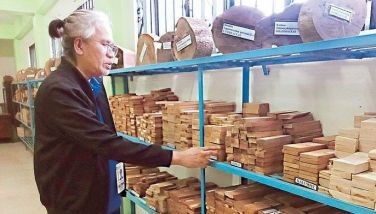Cotabato cassava poisoning being verified
March 14, 2005 | 12:00am
The Department of Health (DOH) said yesterday it is still verifying reports of another case involving cassava poisoning, this time in Cotabato City.
"It is still unvalidated. We’ll have it checked out," Health Secretary Manuel Dayrit said. He did not elaborate.
Earlier reports said Nasrudin Salem and his wife, Fatima, were rushed to the Cotabato Regional Medical Center last Saturday when they started writhing in pain and vomiting after eating boiled cassava tubers.
Doctors said the couple underwent laboratory examinations to determine the best treatment for them.
The DOH is in the middle of investigating a mass poisoning incident in Mabini town in Bohol last Tuesday.
A total of 28 students of the San Jose Elementary School died while 76 others were hospitalized after eating maruya and pitsi-pitsi snacks made from cassava flour during their school recess that day.
The DOH is expecting the results of laboratory tests today to end speculation on what poisoned the children. Health and forensic experts took blood samples from some survivors, as well as food samples and trace evidence from the container of oil used to fry the cassava sweets.
Health experts eyed either naturally occurring cyanide or organophosphate pesticide as possible causes for the poisoning. They said cyanide is inherent in root crops, particularly cassava, while pesticide may have contaminated the cooking oil used to cook the cassava sweets.
The National Bureau of Investigation (NBI), on the other hand, said one of two local vendors who sold these snacks admitted using flour made from a variety of cassava that has a higher cyanide content.
In a telephone interview, NBI Director Reynaldo Wycoco said the vendor, 68-year-old Ana Luyong, told investigators she had used flour made from white cassava instead of the yellow variety.
He said white cassava has a cyanide content between 330 to 360 parts per million while yellow cassava has 30 to 60 ppm. The human body can tolerate a maximum cyanide level of 120 ppm.
"She confided that she used the white variety of cassava because these grew in her backyard. Our experts say this variety contains more cyanide than the yellow cassava variety. Once we have verified everything, we could alert the whole country about the danger of eating the white cassava variety," Wycoco said.
Luyong, who is still confined in a hospital after she ate some of the cassava sweets she prepared, may be charged with reckless imprudence resulting in homicide if it is proven that she knew the dangers of using flour made from white cassava, he added.
The NBI has sent samples of the deadly snack and the frying pan Luyong used to prepare the cassava sweets to its main forensic laboratory in Manila.
Luyong’s fellow vendor, Victoria Hibiya, is now in police custody.
Wycoco earlier said pesticide cans "were found inside the house of the person who cooked the food" and that contents from these cans, which may have been mistaken for flour, could have been used in cooking the cassava treats. — With Mike Frialde
"It is still unvalidated. We’ll have it checked out," Health Secretary Manuel Dayrit said. He did not elaborate.
Earlier reports said Nasrudin Salem and his wife, Fatima, were rushed to the Cotabato Regional Medical Center last Saturday when they started writhing in pain and vomiting after eating boiled cassava tubers.
Doctors said the couple underwent laboratory examinations to determine the best treatment for them.
The DOH is in the middle of investigating a mass poisoning incident in Mabini town in Bohol last Tuesday.
A total of 28 students of the San Jose Elementary School died while 76 others were hospitalized after eating maruya and pitsi-pitsi snacks made from cassava flour during their school recess that day.
The DOH is expecting the results of laboratory tests today to end speculation on what poisoned the children. Health and forensic experts took blood samples from some survivors, as well as food samples and trace evidence from the container of oil used to fry the cassava sweets.
Health experts eyed either naturally occurring cyanide or organophosphate pesticide as possible causes for the poisoning. They said cyanide is inherent in root crops, particularly cassava, while pesticide may have contaminated the cooking oil used to cook the cassava sweets.
The National Bureau of Investigation (NBI), on the other hand, said one of two local vendors who sold these snacks admitted using flour made from a variety of cassava that has a higher cyanide content.
In a telephone interview, NBI Director Reynaldo Wycoco said the vendor, 68-year-old Ana Luyong, told investigators she had used flour made from white cassava instead of the yellow variety.
He said white cassava has a cyanide content between 330 to 360 parts per million while yellow cassava has 30 to 60 ppm. The human body can tolerate a maximum cyanide level of 120 ppm.
"She confided that she used the white variety of cassava because these grew in her backyard. Our experts say this variety contains more cyanide than the yellow cassava variety. Once we have verified everything, we could alert the whole country about the danger of eating the white cassava variety," Wycoco said.
Luyong, who is still confined in a hospital after she ate some of the cassava sweets she prepared, may be charged with reckless imprudence resulting in homicide if it is proven that she knew the dangers of using flour made from white cassava, he added.
The NBI has sent samples of the deadly snack and the frying pan Luyong used to prepare the cassava sweets to its main forensic laboratory in Manila.
Luyong’s fellow vendor, Victoria Hibiya, is now in police custody.
Wycoco earlier said pesticide cans "were found inside the house of the person who cooked the food" and that contents from these cans, which may have been mistaken for flour, could have been used in cooking the cassava treats. — With Mike Frialde
BrandSpace Articles
<
>
- Latest
- Trending
Trending
Latest
Trending
Latest
Recommended






























